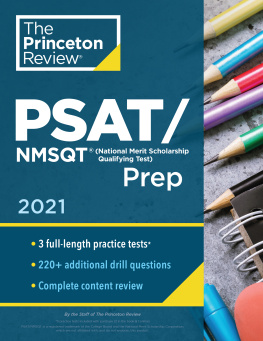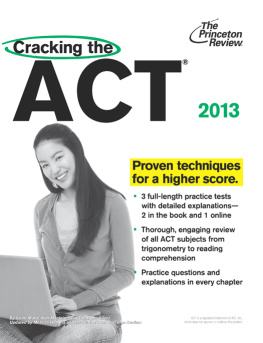Contents
About the Author
Cathryn Still received a Bachelors Degree from Trinity University and a Masters from The University of Texas. She joined The Princeton Review in 1990, starting as a teacher, and ultimately moved into management, where she served as Managing Director of Graduate Programs from 1997 to 2000.
Acknowledgments
Our GMAT course is much more than clever techniques and powerful computer score reports; the reason our results are great is that our teachers care so much about their students. Thanks to all the teachers who have made the GMAT course so successful, but in particular the core group of teachers and development people who helped get it off the ground: Alicia Ernst, Tom Meltzer, Paul Foglino, John Sheehan, Mark Sawula, Nell Goddin, Teresa Connelly, Phillip Yee, Kimberly Beth Hollingsworth, Bobby Hood, Chris Chimera, Chris Hinkle, Peter Hanink, and Cathy Evins.
Special thanks to John Fulmer, National Content Director for GMAT, and Kyle Fox for their hard work revising the current edition.
Special thanks to Adam Robinson, who conceived of and perfected the Joe Bloggs approach to standardized tests and many of the other successful techniques used by The Princeton Review.
Orientation
What Is a Crash Course?
So the GMAT is coming up fast, and all your best intentions of studying an hour a day for the past three months have gone out the window. Not to worrytheres still hope. Crash Course for the GMAT will give you an effective strategy for tackling the GMAT, even though youre down to the wire. After a brief overview of the format of the entire GMAT, well dive right into a ten-step study plan designed to give you the highest possible rate of return. Weve broken down each section by question type, and identified the best strategy for each type of question youll see on the exam. But Crash Course for the GMAT is not a comprehensive study guide for the GMATif you have more time and thats what youre looking for, try The Princeton Reviews Cracking the GMAT.
What Is the GMAT?
The Graduate Management Admissions Test (GMAT) is primarily intended to measure the aptitude of applicants to Masters of Business Administration programs. The test is not an indicator of intelligence, nor will it in any way predict your grades in business school or the likelihood that youll sell your start-up for $50 million three years out. Its just a measure of how well you perform on standardized tests.
The GMAT is made up of three parts:
- An Analytical Writing Assessment (AWA)
- An Integrated Reasoning section
- A multiple-choice section with two parts, Verbal and Quantitative (Math)
Analytical Writing Assessment
The Analytical Writing Assessment (AWA) is a 30-minute section during which you must develop an essay. The essay, called an Analysis of an Argument, requires you to critique the position of an author on a particular dilemma or argument. The test creators have developed a simple word-processing program that allows you to compose your essay on the computer screen.
Integrated Reasoning Section
The 30-minute Integrated Reasoning section consists of 12 items, each of which has multiple parts. Items may contain charts or tables and may ask you to evaluate information from different sources. Most questions feel like math questions, but a few may also test your verbal abilities. The Integrated Reasoning section has four types of questions. The four types of questions are as follows:
- Table Analysis
- Graphics Interpretation
- Multi-Source Reasoning
- Two-Part Analysis
Multiple-Choice Section
The multiple-choice section of the GMAT has two subsections, Verbal and Quantitative (Math).
The 75-minute Verbal section consists of 41 multiple-choice questions, approximately 25 percent of which are experimental (not scored). Well tell you more about the experimental questions later. In this section, youll see three types of questions (in no particular order):
- Reading comprehension (approximately 13 questions and 4 passages)
- Sentence correction (approximately 17 questions)
- Logical reasoning (approximately 11 questions)
The 75-minute Quantitative section of the GMAT contains 37 questions, approximately 25 percent of which are experimental (not scored). There are two types of questions (again, in no particular order):
- Problem solving (1822 questions)
- Data sufficiency (1519 questions)
Who Writes the GMAT?
The GMAT is owned and sponsored by the Graduate Management Admission Council (GMAC), a nonprofit organization with a board composed of top administrators and deans who set the standards for admission to accredited business schools in the United States. The test itself is produced by ACT Inc. (which creates the ACT and develops test questions for a wide variety of standardized tests) and by Pearson Vue, which distributes the exam to testing centers around the country.
Hows It Scored?
Your GMAT scores will be broken down into three separate scores, one for the AWA, one for the Integrated Reasoning section, and one for the multiple-choice section of the test. The AWA essay is graded holistically on a scale of 0 (unintelligible) to 6 (well done).
The Integrated Reasoning section is scored from 1 to 8 in 1-point increments. Questions have multiple parts, and you must answer each part correctly to get credit for the question. The Integrated Reasoning score is not included in the Overall score.
Your performance on each multiple-choice section of the test generates a two-digit number, called the sectional subscore, ranging from 0 to 60. These subscores are combined into a three-digit number, called your composite, or overall, score. Overall scores range from 200 to 800. The average (50th percentile) GMAT score is around 550, while a score of 710 would be above the 90th percentile. A 700 is currently the 89th percentile.
Scores on the AWA, Integrated Reasoning, and multiple-choice portions of the exam are separatethey do not affect each other in any way.
Experimental Questions
Scattered throughout the Verbal and Quantitative sections of the test are questions that do not count toward your score. These are experimental, or research, questions, and their sole purpose is to generate data for GMAC. You will not recognize the experimental questions; they look and feel just like the real things. GMAC uses your performance on these questions to determine their viability and to generate scoring statistics for them.
What Do You Guys Know, Anyway?
The Princeton Review has been monitoring the GMAT for years. Our teaching methods were developedand are continually honedthrough regular, detailed analyses of what topics are tested on the GMAT and how these topics are tested. We teach strategies that allow you to quickly discern the most efficient and safest path to take in answering questions, and techniques that help you take control of the testing structure and environment, and even use them to your advantage.















